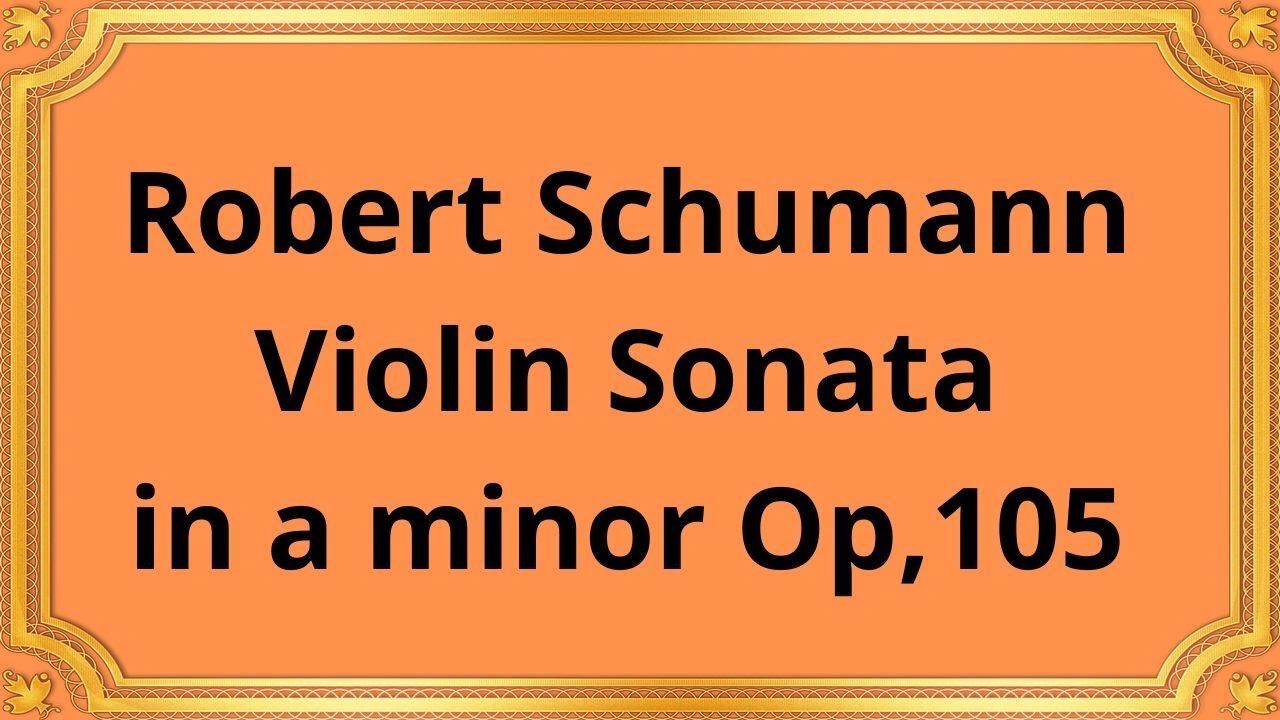Premium Only Content

Robert Schumann Violin Sonata in a minor Op,105
#Schumann #ViolinSonata #ClassicalMusic #MusicalComposition #Aminor #Op105 #RomanticMusic #Composer #Violin #Piano
Publication date 1939
Leo Petroni (violin)
Michael Raucheisen (piano)
Robert Schumann, a prominent composer of the Romantic era, crafted numerous compositions that continue to captivate audiences to this day. Among his notable works, the Violin Sonata in A minor Op. 105 stands out as a remarkable piece of music.
The Violin Sonata genre emerged during the Classical period but reached its pinnacle during the Romantic era. This genre showcases the expressive capabilities of both the violin and piano, often featuring virtuosic passages and emotional depth. Schumann's Violin Sonata in A minor Op. 105 exemplifies the essence of this genre, highlighting his compositional prowess and ability to convey profound emotions through music.
Schumann composed the Violin Sonata in A minor Op. 105 in 1851. The piece consists of three movements, adhering to the traditional structure of a sonata:
1. Mit leidenschaftlichem Ausdruck (With passionate expression): This movement begins with a somber and melancholic theme, which gradually intensifies, incorporating moments of both turmoil and tenderness.
2. Allegretto: This middle movement features a contrasting character, offering a more delicate and lyrical melody. It serves as a contemplative interlude between the emotional extremes of the outer movements.
3. Lebhaft (Lively): The final movement is characterized by its lively and energetic nature. It showcases Schumann's virtuosic writing for both the violin and piano, culminating in a triumphant and exhilarating finale.
Schumann's Violin Sonata abounds with expressive and poignant melodies, allowing the performers to convey a wide range of emotions. From the melancholic to the exuberant, the composition showcases Schumann's gift for crafting memorable and emotionally charged themes.
The piece explores a wide spectrum of dynamics, ranging from delicate and intimate moments to powerful and dramatic passages. The dynamic contrasts contribute to the overall emotional depth and intensity of the composition.
Schumann's use of harmonies in Op. 105 is both intricate and evocative, creating lush and colorful textures throughout the piece. The harmonic progressions add depth and complexity to the musical narrative.
The composition features a captivating interplay between the violin and piano, with each instrument taking turns in leading and supporting roles. This dialogue between the two instruments enhances the musical storytelling and creates a sense of intimacy and collaboration.
Schumann's Violin Sonata in A minor Op. 105 holds significant importance within the realm of classical music. It represents a pinnacle of Romantic-era composition, showcasing Schumann's ability to convey deep emotions and evoke a profound connection with the listener. The work continues to be admired for its expressive melodies, harmonic richness, and the virtuosic demands it places on the performers. It has become a staple of the violin repertoire and a testament to Schumann's enduring legacy as a composer.
Conclusion:
Robert Schumann's Violin Sonata in A minor Op. 105 is a testament to the composer's mastery of the Romantic style. With its expressive melodies, dynamic contrasts, and harmonic richness, the composition remains a captivating and emotionally stirring piece of music. It stands as a testament to Schumann's ability to convey profound emotions through his compositions and continues to be cherished by audiences and performers alike, cementing its place as a timeless masterpiece within the classical music canon.
You have the opportunity to support the channel:
https://destream.net/live/RadSiarAl/donate
https://www.buymeacoffee.com/6355radsiaral
-
 23:19
23:19
Classical music_Music Inspiration
3 days agoLudwig van Beethoven Sonata No. 23 in F minor, Op. 57 "Appassionata"
201 -
 LIVE
LIVE
Lofi Girl
2 years agoSynthwave Radio 🌌 - beats to chill/game to
249 watching -
 44:41
44:41
Inverted World Live
12 hours agoPolitical Violence in Minnesota w/ AK Kamara
160K18 -
 6:29:40
6:29:40
SpartakusLIVE
12 hours ago#1 Massive MEAT-HEAD can't stop WINNING, can't stop FLEXING
80.3K -
 5:09:25
5:09:25
Drew Hernandez
13 hours agoGIDEON AI THREAT DETECTION SOFTWARE PUSH & NEW EPSTEIN EMAIL LEAK?
48.8K26 -
 2:03:51
2:03:51
TimcastIRL
9 hours agoTrans Minneapolis Shooter BLAMED Massacre On Mom & Gender Transition | Timcast IRL
187K348 -
 47:29
47:29
Man in America
15 hours agoIT DOESN'T ADD UP: The Trans Shooter's Story Is FULL of Holes
59K66 -
 3:59:36
3:59:36
StevieTLIVE
8 hours agoFriday Night Warzone HYPE
44.5K1 -
 3:47:10
3:47:10
SynthTrax & DJ Cheezus Livestreams
1 day agoFriday Night Synthwave 80s 90s Electronica and more DJ MIX Livestream Michael Jackson / AI Art Compilation Edition
53K2 -
 1:03:57
1:03:57
Sarah Westall
9 hours agoMara Lago Accord Joins the Fed, Fed Waves the White Flag & more w/ Andy Schectman
34.8K2